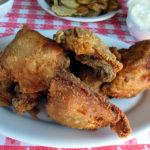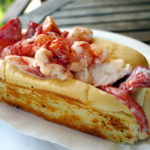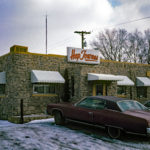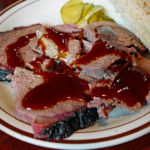Bridges Barbecue Lodge And Caro-Mi Dining Room
The Caro-Mi Dining Room in Tryon, North Carolina, is "the most divine dining room of the gentle South," a culinary tipster advised us. "You won't believe the ham," she wrote. "It is country-style, with grits and gravy and all the trimmings. As for fried chicken, there is none better. And be sure to see the front porch. Sit there awhile, and you will know what I mean when I tell you that Caro-Mi is God's country. Be sure to come hungry." The note was so convincing that we didn't even look for anything to eat when we eventually got to Charlotte. We immediately headed west on Highway 74 toward the Blue Ridge Mountains, with the intention of experiencing Caro-Mi with appetites raging.
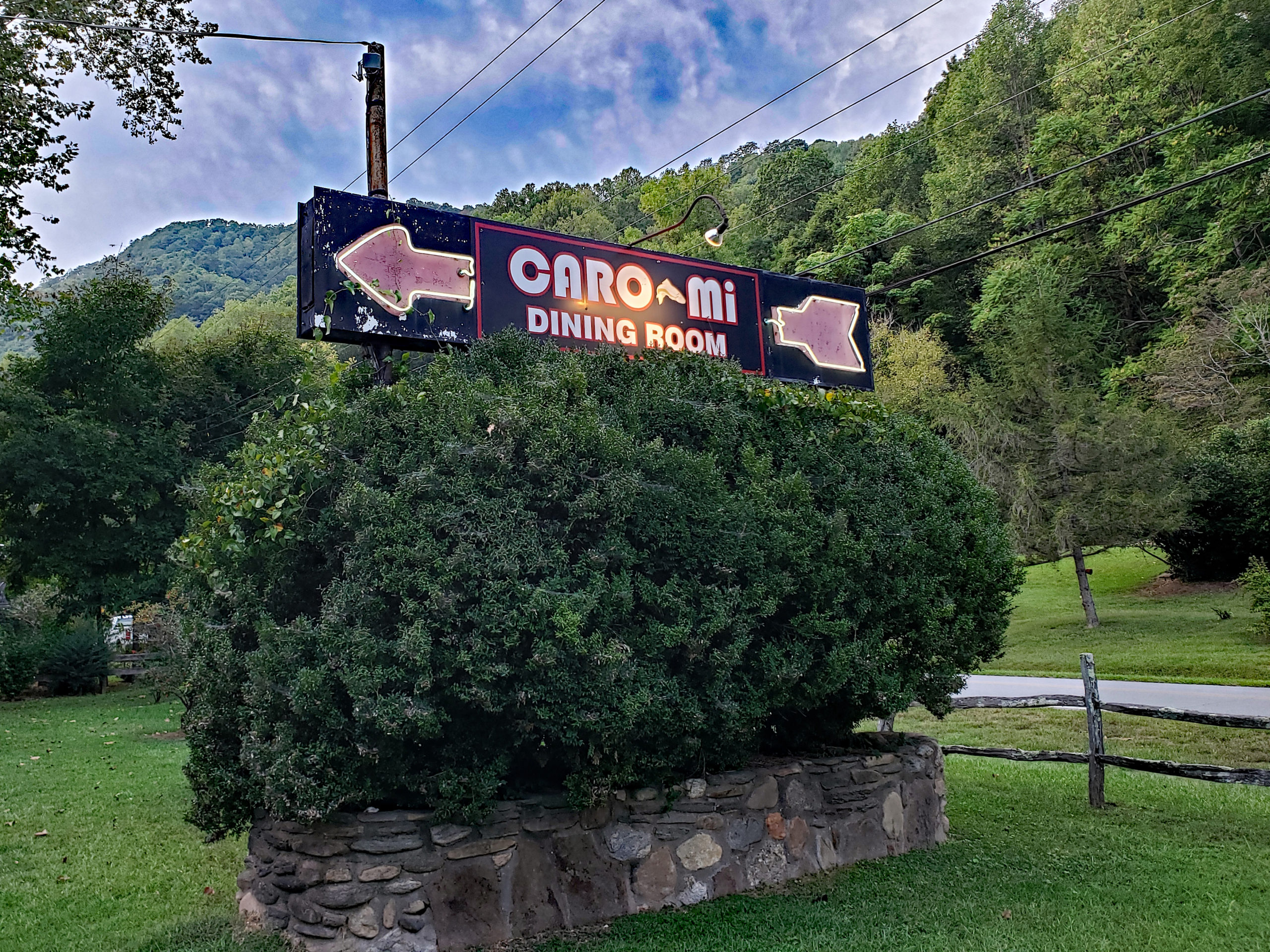
By Jane and Michael Stern
Originally Published 1994 Gourmet Magazine
The Caro-Mi Dining Room in Tryon, North Carolina, is “the most divine dining room of the gentle South,” a culinary tipster advised us. “You won’t believe the ham,” she wrote. “It is country-style, with grits and gravy and all the trimmings. As for fried chicken, there is none better. And be sure to see the front porch. Sit there awhile, and you will know what I mean when I tell you that Caro-Mi is God’s country. Be sure to come hungry.” The note was so convincing that we didn’t even look for anything to eat when we eventually got to Charlotte. We immediately headed west on Highway 74 toward the Blue Ridge Mountains, with the intention of experiencing Caro-Mi with appetites raging.
But that was before we gazed upon BRIDGES BARBECUE LODGE. It beckoned invitingly by the side of the highway in the town of Shelby, about an hour’s drive outside Charlotte. A huge meat-cooking pit, the size of a small motel, adjoins the lodge, and the aroma seeping from it—a faint haze of smoldering hickory wood and sizzling pork—was more alluring than any perfume from Paris. We wavered until we noticed an almost certain sign of good roadside food in almost any region: police cars in the parking lot. When it comes to breakfast breadstuffs (biscuits or doughnuts in particular), cream pies, and barbecue, the police are well nigh infallible fines bouches. We pulled off the highway and parked between two squad cars. Surely, heaven could wait for a couple of plates of North Carolina pit-cooked Q.
The Bridges dining room is plain and soothing, with the kind of meditative atmosphere unique to the finest pork parlors of the mid-South. Strange, square wooden chandeliers cast soft light over turquoise booths and a short counter up front where single diners chat quietly between sips of buttermilk and forkfuls of barbecue. Five police officers with gleaming automatics in shiny leather holsters occupy a table toward the back, and they, too, speak in hushed tones. (During our meal, a few more lawmen walk in to join their colleagues, each one giving us a not-so-subtle onceover as he enters. We are seated in a booth near the front, and, unlike everybody else in the place, we are strangers. Apparently we don’t look like outlaws, because after scrutiny we receive a friendly salute and a welcoming “howdy” as each trooper walks past.)
There isn’t much to speak of in the way of decor at the lodge, certainly nothing to distract you from the business at hand, which is grappling with a formidable heap of smoke-cooked pork. An oil portrait of the founder, Red Bridges, hangs on the dark wood-paneled wall, and a few family photographs overlook the cash register. In the front of the restaurant, illuminated glass cases contain about a hundred different pig figurines—saltshakers, toothpick holders, paper-weights, and the like.
There is no formal menu, just the slip of paper used by the waitress to take orders. It has the (short) list of what’s available, which she’ll explain if you are not an experienced barbecue eater. Our waitress turns out to be a big fan of local soft drinks to accompany the Q. “Cheerwine is cherry,” she tells us, “but my favorite is Sun-Drop. It’s like Sprite but more citrusy, and better. You’ll like it with your pork.” We sure do.
Basically, you can get a sandwich, a tray, or a plate. A sandwich sells for $2. The biggest of all plates, a jumbo, costs $7. A tray is simply barbecue and barbecue slaw; a plate also holds French fries, lettuce, tomato, and pickle. Both are accompanied by a basket of hush puppies, and, whether you select sandwich, tray, or plate, you will have to decide whether you want your meat minced, chopped, or sliced. This is a major decision, for the different preparations are almost like three different foods. The minced and chopped meats are hashes of delicious pork, held together by a lot (the minced pork) or a smidgen (the chopped) of a uniquely North Carolinian sauce—tomato based but with a strong vinegar tang. The sauce brings out all the good qualities of the carefully tended meat. Sliced barbecue means big, soft pieces, mostly white and as tender as pork can be, faintly fragrant of the smoke pit. Sauce doesn’t infuse a slice nearly as much as it does the minced or chopped pork, but if you like the texture and ultra-porcine taste of slices and also the flavor of the smoky red stuff, there is an extra Styrofoam cup of sauce on the table.
The hush puppies at Bridges are unusual: elongated crescents with a brittle, sandy-textured crust. They offer a chewing experience exactly the opposite of the pillowy sliced pork. The slaw is odd, too, if you are expecting anything like typical coleslaw. The finely chopped cabbage is bound together with a ketchup-based sauce. It’s got real zest, and the pearlescent cinnabar hue is a handsome complement to your pork of choice.
The drive from Shelby to Tryon normally takes less than two hours, but we travel very slowly, along the smallest roads we can find, with the windows rolled down to inhale maximum amounts of bracing country air. The byways begin to twist and climb toward the Blue Ridge Mountains, and the scenery is bucolic: Cows graze, horses gather under shade trees, old tobacco signs crumble on the sides of listing barns. A roadside stand advertises local honey, preserves, and a $5-per-quart special deal on sorghum molasses (“Limit, two per customer”). By the time we get to Tryon, “The Friendliest Town in the South,” according to its welcome sign, visions of country ham dance in our heads.
You cannot miss the CARO-MI DINING Room, which got its name because the original owners spent equal amounts of time in the Carolinas and Miami, Florida, when they opened the restaurant in 1945. From the road you scarcely see the place, but you do see the Caro-Mi covered bridge, which takes you from the parking lot, just off Highway 176, over the Pacolet River to the restaurant on the other side. It is a double-barreled bridge with a walkway for pedestrians and a roadway for cars (speed limit: 1 mile per hour). A stroll along it over the rushing water is a trip back in time to the middle of the century and to an unaffected supper of immemorial southland fare.
It is a good-sized place to eat. There are four airy dining rooms that seat 150 altogether. The walls are pine-paneled, and the floor is hardwood. If you look closely, you can see how the floorboards sag as a result of the well remembered flood of 1977, in which the waters were so high that the original covered bridge (one of only three in the state) was washed away. Caro-Mi is a rustic, woodsy kind of establishment, but it has some amenities. Red-checked cloths are draped over sturdy wooden tables. Candles flicker above plastic dishes. In nice weather, windows are opened and you can feel the evening breeze and hear the river flow. The walls of one dining room are decorated with vintage pennants from college teams, gifts from returning customers who are as loyal to Caro-Mi as to their alma maters. As it nears its fiftieth birthday next year, this old-time mountain dining room remains a familiar destination for generations of travelers who appreciate the gentle charms of western North Carolina.
Every meal begins with relishes in little pink bowls with a teaspoon in each for serving—a dish of sweet-pepper—laced macaroni salad and another of coleslaw composed of limp shredded cabbage and a zesty vinegar dressing. A stack of saltines partners a little glass container about the size of a baby food jar that holds dark golden apple butter.
As you sample these pleasant offerings, Charles Stafford, the proprietor, comes along to explain the menu, which almost never changes except in the weeks before Christmas, when he adds a specialty—Greek-style prime rib roasted with garlic, oregano, turnips, onions, and fresh lemon juice. A lot of customers do not need his guidance and disdain the menu: They know they want the same fried chicken they’ve ordered since their parents brought them to Caro-Mi on family vacations. But even if you know exactly what you want, we suggest you let Mr. Stafford rhapsodize about his kitchen’s marvels. This is a man who relishes what he serves and whose enthusiasm for it all is a delightful starter.
He sings about the steaks, boasting that they are aged for four weeks and that the T-bones have a big, succulent filet side. The shrimp in the shrimp cocktail and in the cold boiled shrimp dinner are big ones, he gloats, boiled and peeled with loving care. He says that when he went to the market that morning he found some lovely fresh chicken and that a shipment of fine old hams arrived only just the other day.
“Ours is real country ham,” he points out. “It is cured with salt—just enough—and brown sugar. Period. No nitrates or nitrites, no chemicals at all. It is aged ham, ham that has hung for at least a year. We get it from the same ham house Caro-Mi has used since the beginning.” If you want to know even more, he is only too happy to oblige, describing in precise detail how each day the chef, Preston Vernon, rubs the mold from the ham, slices it, then scrapes all the bone marrow off each slice.
At a nearby table, two elderly women with tight white perms, pastel dresses, and orthopedic walking shoes do not give Mr. Stafford a chance to recite the day’s delights. “Ham!” one calls out as he first approaches the table with menus in hand. They don’t even want to touch the menus. “Ham for two!” the other one hollers the way hard-of-hearing people sometimes do. If more than one person at the table orders ham, it is served family-style, stacked on a platter. The slices glisten with redeye gravy that is clear and lustrous, and they are accompanied by a bowl of creamy grits. This is sturdy ham with good tooth resistance, but it is not at all tough. Nor is there so much salt that the complex flavor of the luxurious meat is masked by its curative. This ham is elegant: powerful, yes, but civilized.
Now, almost any kind of ham by itself is pretty appetizing fare, but country ham is something extraordinary, and its traditional accoutrements in this part of the world make it one of America’s sublime gustatory experiences. There is that strange gravy, named, so some stories go, because, if you prepare it correctly and respect the fact that ham drippings and black coffee don’t really mix, it resembles nothing so much as a bloodshot eye staring back at you from the serving pitcher. Made from the salty old ham’s rendered trimmings, redeye gravy is, quite simply, the essence of country ham.
Served in a bowl alongside the ham, the grits have a smooth, buttery blandness that complements the strong flavor of the cured meat. Even if you aren’t a grits person at breakfast, you may find them a welcome taste experience at supper. There is no better foil for country ham. Biscuits, in this case, also play second fiddle to the ham. They are demure little discs, soft and bready, a good way to mop up every bit of gravy and to ferry apple butter from its serving dish.
Green beans come alongside each meal, too—served family-style, like all the side dishes, so you can help yourself to as much as you want. (Complimentary seconds are whisked to the table whenever a bowl is emptied.) The beans are deep green, and they are a far cry from the al dente ones you find in most trend-conscious American restaurants. Slowly simmered with ham hocks, these beans develop a burnished flavor that no briefly boiled, crunchy ones could deliver. They are amazingly soft, without even the memory of a crunch, the gentlest vegetable you ever bit.
Best of all the ham’s companions are the cooked apples (prepared, from June through October, with just-picked fruit grown on trees in neighboring Saluda). Quartered sections are simmered long enough to turn limp and dark. On the verge of becoming applesauce, the weighty segments fairly burst with sweet flavor and counter all the salty, meaty qualities of the ham.
Stafford and his wife, Annette, bought Caro-Mi just four years ago, but he started here as an employee, waiting tables in the early seventies. “Our goal,” he explains, “is continuity. We want Caro-Mi to be the way everyone remembers it. We haven’t changed the recipes at all, and some of them go way back. The slaw dressing recipe, I can tell you, comes from an era before refrigeration. The ham and the fried chicken are prepared in time-honored ways. So is the trout, which has brought returning customers for decades.” The trout is a house specialty: classic rainbow trout, sautéed in butter to a parchment crisp and brought to the table whole. There the waiter or waitress neatly nips off the head, splits the fish to remove the bones, then dollops on dark, syrupy almond butter from a gravy boat. The meat is moist and mountain-stream fresh, separating neatly into luscious hunks. There are few flavors that evoke the outdoors and summertime as conclusively as this panfried sweetie.
Although Charles Stafford has worked in the restaurant business most of his life, running Caro-Mi is his most ambitious venture so far. But he is unfazed by the challenge. “It is easy to maintain the continuity here,” he says. “I have Preston Vernon. He is the star of the show. He is the heart and soul of Caro-Mi.”
A handsome man whose front teeth glitter with a gold heart, star, and diamond, Mr. Vernon says, “I began at Caro-Mi on April the sixteenth, nineteen and fifty-nine. I was still in high school. My job was washing dishes, but I knew something about cooking from watching my grandmother do it. After I worked here two weeks, the cook quit. The manager back then asked me if I wanted to give it a shot. So I did, and I have been the cook ever since.” Many of the entrée recipes were already in place when Mr. Vernon took over the kitchen: Fried chicken, ham, trout, and steak had been on the menu since the beginning. He added his own touch in the form of family recipes. The cooked apples, for example, are made exactly the way his grandmother used to. The biscuits are hers as well. And the macaroni salad is Mr. Vernon’s invention.
The chef’s specialty, available when Mr. Stafford can find good ones on his daily morning visits to the local market, is sautéed chicken livers. This, too, is a Vernon family recipe, and it perfectly embodies the seductive charms of Caro-Mi, at once homespun and deluxe. The livers are dusted with flour and given jots of black pepper and paprika before being sautéed in an iron skillet with onions. They are turned only once, so they develop a crusty surface but retain their lush delicacy. They make a rich and satisfying supper, the kind of comfort food you might expect to get at home but seldom find in a restaurant.
The best part of a meal at Caro-Mi just may be the afterglow. When you are done with dessert, step outside to the wide front porch where a dozen rocking chairs stand in a row. Rock a spell. Listen to the river run. Watch couples pause and gaze down at the water as they amble hand in hand across the covered bridge. If the breeze is blowing right, you breathe in the scents of sizzling ham and trout, biscuits hot from the oven, sweet apples stewing on the stove. Maybe the Caro-Mi Dining Room isn’t heaven, but this little spot in the western hills of North Carolina will do just fine until it’s time to try the macaroni salad at the great buffet up yonder.
Article Recipes
To prepare and bake a whole country ham requires a hacksaw, a gigantic stock-pot, and an assistant able to bench-press his or her own body weight. Your home may smell of pig for days, and for some people the sight of the ham itself when it emerges from its burlap sack is a true horror—like a barnyard monster invented by Stephen King, all covered with mold. The mold must be scrubbed off and the ham must be soaked in several changes of water for twelve to twenty-four hours. For these reasons we order ready-to-fry, center-cut slices of country ham by mail from the Loveless Motel & Cafe outside of Nashville (address below). Loveless hams are salt-cured, hickory-smoked Tennessee beauties. About the redeye gravy: Some people who really love the pure taste of ham and have the drippings from a good strong one in their skillet use no coffee at all—just enough plain water to make the fat pourable. Use the extra gravy to pour on grits.
Caro-Mi Dining Room
Discuss
What do you think of Bridges Barbecue Lodge And Caro-Mi Dining Room?
Related Articles
Stroud’s
By Jane and Michael Stern Originally Published 1995 Gourmet Magazine Chicken...
The Lobster Roll Honor Roll
Maine is the only state in America that features a picture of cooked food on its license...
Meat-And-Three
A few years back, country singer Ray Stevens invited a New York friend to join him at one of...
Top 12 favorite Ice Cream Scoops
WITH THE EXCEPTION of the hot dog bun, there has never been an edible invention as...
Top 5 BBQ Restaurants | Western Kentucky
Get yourself to Western Kentucky for great BBQ I see the food shows on TV where...
Best restaurants in Greenwood, MS | Hot Licks Delta Style
Ever since we first ate margarine-sauced pompano at Lusco’s, in Greenwood,...

